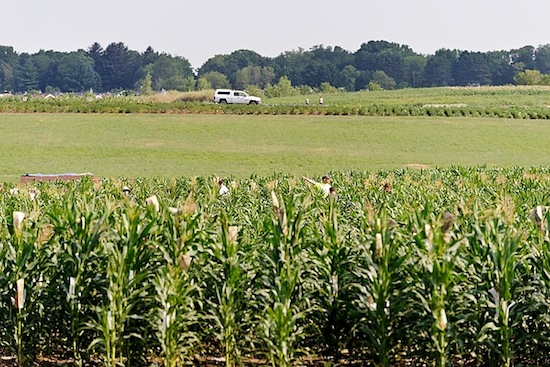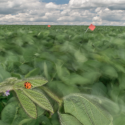Despite drought, heat and higher costs, state farm income was second highest ever

While net farm income in Wisconsin was down in 2012, it was still the second highest annual amount on record, according to the yearly Status of Wisconsin Agriculture report edited by UW–Madison emeritus professor Ed Jesse. Farmers who grew enough of their own feed did better than those who had to buy it.
Photo: Jeff Miller
Despite the challenges brought on by prolonged drought and record-breaking heat, Wisconsin farmers earned $3 billion in net farm income in 2012, the second highest amount on record.
While that’s down 21 percent from 2011, it’s $1 billion more than they earned in 2010.
But how the year worked out for individual farmers varied considerably depending on where in the state they farm and what they produce, says agricultural economist Ed Jesse, editor of the 2013 Status of Wisconsin Agriculture report.

Jesse
“If you’re a dairy farmer who had enough feed grown on your own farm, for example, you did okay. If you’re buying every kernel of corn that you feed, you probably didn’t do very well,” says Jesse, University of Wisconsin–Madison emeritus professor of agricultural and applied economics.
The report, authored by UW–Madison and UW-Extension agricultural economists and commodity specialists, was released Wednesday, Jan. 23 in Madison at the annual Wisconsin Agricultural Economic Outlook Conference.
Wisconsin’s gross farm revenues climbed $100 million from the previous year to set a new record in 2012, the report estimates. The increase in total income was due to higher prices for most commodities, corn in particular, even though total crop sales were down by $180 million because of drought-decreased yields.
But higher costs more than offset the gain in revenues, causing net income to drop $800 million, the authors add. The state’s farmers spent about 13 percent more for inputs and services in 2012. Feed costs accounted for more than half of the increase, but spending was also up 12 percent for seed, 9 percent for fertilizer, and 15 percent for pesticides. The average cash rent for land rose 16 percent to $115 per acre.
Returns to dairy farmers suffered in 2012. Despite lower milk prices, farmers’ gross revenues from milk were about the same as in 2011 because of higher production. But higher feed costs cut deep into the profit margins of producers who don’t grow their own dairy rations and of those who had to replace homegrown feed where crops failed.
Wisconsin milk production set a new record for the seventh consecutive year. It rose 4.1 percent — well above the national increase of 1.9 percent — to 27 billion pounds. And Wisconsin’s cows had an above average boost in milk output. Milk per cow rose 3.6 percent here — the largest increase since 2005 — compared to 1.9 percent nationwide.
UW dairy analysts Mark Stephenson and Bob Cropp project that the average milk price paid to the state’s dairy farmers in 2013 will be $20.15, up 90 cents from 2012. If the futures market is any indication, soybean meal prices will decline, while corn prices will remain high until harvest and then decline, they add. “This combination of higher milk prices and an easing of feed prices would improve farm margins significantly,” they note.
How the year worked out for individual farmers varied considerably depending on where in the state they farm and what they produce.
But they admit that their crystal ball is cloudy. “There is always uncertainty surrounding any forecast, but there may be more of it in 2013,” they write. If drought persists and feed prices remain high, milk production would tighten further. With continued strength in world demand for dairy products, “we could see milk prices exceed our forecasts in the second half of the year,” they say.
Among the report’s other findings:
- The drought sharply reduced yields of non-irrigated processing vegetables, and high temperatures set back pollination and growth even on irrigated vegetables. But yields of potatoes, most of which are irrigated, were up significantly, thanks to a mild spring that allowed early planting followed by a very warm early summer that spurred rapid tuber growth.
- Apple production was down 60 percent due to a sequence of abnormally warm temperatures in March, which triggered early budding, followed by a hard frost in April. But yields varied. Some growers had exceptional yields and quality; others lost up to 90 percent of the crop. The tart cherry crop was down 90 percent.
- Aggregate net worth strengthened. Assets increased about $4.4 billion while debt was up $700 million. Real estate accounts for three-quarters of farmers’ net worth and two-thirds of their debt.
- Relative debt levels changed little. The average debt-to-asset ratio was 13 percent at the end of 2011. That’s up from 12 percent five years ago, mostly due to more real estate debt, but it’s still a healthy financial position. There’s no sign of a repeat of the farm debt crisis of the 1980s, when plunging land values and large real estate debt sent the debt-to-asset ratio above 25 percent.
The Status of Wisconsin Agriculture report is produced by the UW–Madison Department of Agricultural and Applied Economics and the Renk Agribusiness Institute.
Tags: agriculture, dairy

